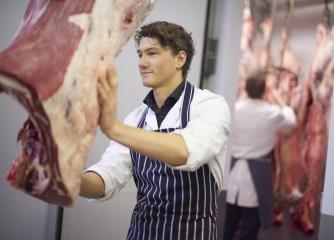Summary

| Quick Facts: Butchers | |
|---|---|
| 2023 Median Pay |
$37,650 per year
$18.10 per hour |
| Typical Entry-Level Education | No formal educational credential |
| Work Experience in a Related Occupation | None |
| On-the-job Training | Long-term on-the-job training |
| Number of Jobs, 2023 | 139,100 |
| Job Outlook, 2023-33 | -2% (Decline) |
| Employment Change, 2023-33 | -2,900 |
What Butchers Do
Butchers cut, trim, and package meat for retail sale.
Work Environment
Most butchers work in grocery stores and specialty meat shops. The work can be physically demanding and may include exposure to repetitive motions, dangerous equipment, and cold temperatures.
How to Become a Butcher
Butchers typically need no formal educational credential. They learn their skills on the job.
Pay
The median annual wage for butchers was $37,650 in May 2023.
Job Outlook
Employment of butchers is projected to grow 2 percent from 2023 to 2033, decline.
About 16,100 openings for butchers are projected each year, on average, over the decade. Many of those openings are expected to result from the need to replace workers who transfer to different occupations or exit the labor force, such as to retire.
State & Area Data
Explore resources for employment and wages by state and area for butchers.
Similar Occupations
Compare the job duties, education, job growth, and pay of butchers with similar occupations.
More Information, Including Links to O*NET
Learn more about butchers by visiting additional resources, including O*NET, a source on key characteristics of workers and occupations.





